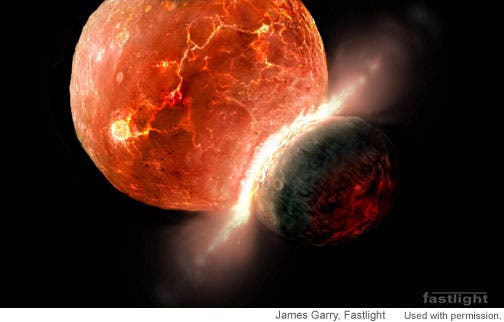The Moon has fascinated researchers and poets alike since ancient times, but while the latter all agree on its beauty, scientists are still debating how the satellite was formed; recently, a new isotopic analysis seems to shed some new light on the matter, making things even more interesting than they were before.
Most believe that the Moon was formed when a hypothetical planet about as big as Mars, name Theia crashed into the Earth early in its existence, and the dramatic collision created a disc of magma which started to orbit our planet and later formed the Moon. This is called the giant impact hypothesis, and computer models indicate that at least 40 percent of the magma would have come from Theia, and one way to test this is to analyze isotopes of particular elements in rocks returned from the moon. Isotopes are variants of a particular chemical element, with the same number of protons, but different number of neutrons.
Oxygen, for example has three isotopes: 16O, 17O and 18O, indicating differences in the number of neutrons each nucleus contains. Compare any two samples of oxygen found on Earth and you’ll find the proportions of 16O, 17O and 18O isotopes are almost identical in the two samples. The problem here was that previous isotopic analysis revealed that the Moon’s composition was very similar to that of the Earth – which doesn’t quite fit with the idea that 40 percent of the magma came from Theia, because it had a significantly different composition. However, a theory claimed that it’s possible that Earth may have exchanged oxygen gas with the magma disk that later formed the Moon shortly after the collision, explaining why the results are the same.
However, this new research showed that the proportion of 50Ti to 47Ti, which is another good indicator of whether a certain sample came from Earth, is also effectively the same on our planet and on the Moon. So what’s the difference between Titanium and Oxygen? Well, while an oxygen exchange between our planet and its satellite is perfectly possible, such a Titanium exchange would be practically impossible, because of the element’s very high boiling point.
“The oxygen isotopic composition would be very easily homogenized because oxygen is much more volatile, but we would expect homogenizing titanium to be very difficult.”
So if a giant collision didn’t do it, then what formed the Moon? A possibility is that of a glancing blow from a passing body left Earth spinning so rapidly that it threw some of itself off into space like a shot put, forming the disk that coalesced into the moon, which would perfectly explain why the Moon is so similar to Earth in terms of geochemistry. But there are some serious issues with this model as well, especially in explaining where all the extra angular momentum went after the moon formed.
Via ScienceMag







